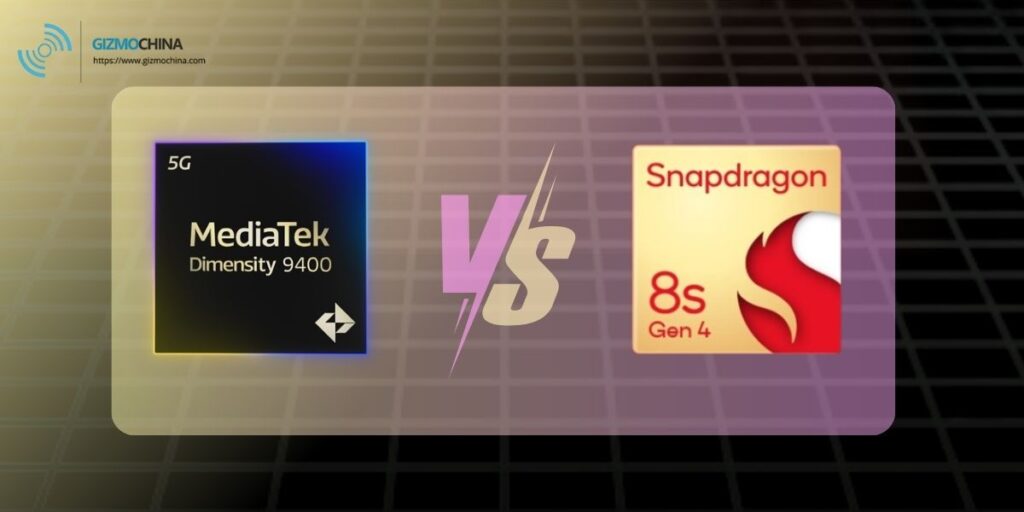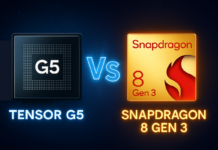Smartphone chipsets have reached a point where even the so-called “sub-flagship” SoCs pack more power than most users need in their day-to-day usage. But when comparing something like MediaTek’s Dimensity 9400 (a proper 2025 flagship) to Snapdragon’s 8s Gen 4, which sits just below the top-tier Snapdragon 8 Gen 4, it becomes more about how much better the flagship actually is, rather than if it’s better.
This isn’t just about specs on paper. It’s a look at how both chips stack up in real-world relevance. From performance and AI to gaming, camera tech, and power efficiency. Here’s what you need to know.

1. Performance
Starting with CPU performance, MediaTek’s Dimensity 9400 clearly flexes its flagship status. It’s running a second-gen all-big-core architecture from ARM. The prime is a Cortex-X925 core clocked at 3.62GHz backed by three Cortex-X4 cores and four Cortex-A720s.
The SoC also has bigger L2 and L3 caches (2x and 1.5x, respectively) and a 15% IPC uplift over the previous generation, which official claims delivers up to 35% better single-core and 28% better multi-core performance compared to its predecessor.
On the other hand, Snapdragon’s 8s Gen 4 keeps things a little more measured. The Cortex-X4 prime core tops at 3.2GHz while the rest are Cortex-A720 cores — three clocked at 3.0GHz, two at 2.80GHz, and the remaining two at 2.0GHz. Qualcomm claims the setup delivers a 31% performance boost over the 8s Gen 3.
Essentially, 8s Gen 4 is meant to offer strong performance where it counts without breaking the power budget.
2. Gaming
Gaming is one area where both chips make big promises.
The Dimensity 9400 uses the Immortalis-G925, a 12-core GPU based on ARM’s 5th-gen architecture. It’s not just about brute force, though. MediaTek has layered in hardware-based ray tracing, up to 44% better power efficiency, and features like opacity micromaps that make scenes feel more complex without actually being so.
There’s also MediaTek’s HyperEngine Gaming Tech 3.0 offering real-time FPS stabilization, upscaling with Frame Rate Converter, and AI-driven resolution scaling.
Qualcomm’s Adreno GPU in the 8s Gen 4 is no slouch either. It uses sliced architecture like the flagship Snapdragon 8 Elite and delivers up to 49% better graphics performance versus its last-gen counterpart.
The chip also has features like Snapdragon Elite Gaming, Adaptive Performance Engine, Game Super Resolution 2.0, and even hardware ray tracing to help it stay competitive in most real-world gaming scenarios.
The 9400 is ahead for gaming purists who care about every frame, lighting effect, and temperature drop. But the 8s Gen 4 doesn’t feel far behind for more mainstream gaming.
3. AI
We can’t miss AI in 2025, of course. And both chips were designed with this in mind.
The Dimensity 9400 uses MediaTek’s 8th-gen NPU and goes all-in on what it calls “Agentic AI.” It’s the first mobile chip to support on-device video generation, LoRA model training, and diffusion transformers.
The performance numbers are also aggressive. The company claims it has double the diffusion generation speed and 80% faster LLM prompt handling compared to the Dimensity 9300. It also supports more complex models like Diffusion Transformers and Mixture of Experts (MoE), which are increasingly central to AI workloads.
Qualcomm’s 8s Gen 4 doesn’t trail far behind. It’s Hexagon NPU supports on-device LLMs and LVMs, and on-device multimodal and multilingual AI assistants. It delivers 44% faster AI performance and has 2x larger memory bandwidth than last-gen.
All in all, it’s no surprise the Dimensity 9400 is ahead in raw AI horsepower and capabilities. But unless you’re really into on-device generation or AI training, the 8s Gen 4’s capabilities will feel just as seamless for regular folks.
4. Cameras
Both chips offer solid camera support with advanced AI-assisted photography. The Dimensity 9400’s Imagiq 1090 ISP is particularly impressive. It enables continuous HDR video capture across zoom ranges, real-time AI segmentation, and generative AI super-resolution up to 100x zoom. Plus, MediaTek promises enough power efficiency to record 4K 60fps video for three hours straight.
The Snapdragon 8s Gen 4 brings Qualcomm’s Spectra AI ISP, with 18-bit capture and support for 320MP sensors. It can handle real-time semantic segmentation and night vision 2.0, capturing 4K 30fps footage in low-light conditions. You’re also getting skin and sky tone correction in real-time, which is useful in everyday shots.
5. Connectivity
The Dimensity 9400 uses a 3GPP Release-17 modem with 7 Gbps peak sub-6 5G speeds and new power-saving tricks like UltraSave 4.0. It also supports Wi-Fi 7 with tri-band concurrency, and MediaTek’s Xtra Range 3.0 for reliable network coverage.
Snapdragon’s 8s Gen 4 maxes out at 4.2 Gbps on 5G, 5.8 Gbps on Wi-Fi 7, and supports Bluetooth 6.0. It also has support for features like Bluetooth Channel Sounding and Snapdragon Seamless to help switch devices fluidly within the ecosystem.
6. Final Thoughts: Flagship or Just Enough?
So, where do we land?
The Dimensity 9400 is very much a flagship chip. Big cores, big cache, top-shelf AI, serious gaming credentials, and advanced camera and connectivity features. The spec sheet says it all!
The Snapdragon 8s Gen 4 is a more affordable chip that brings enough of Snapdragon’s ecosystem to power premium devices at a lower cost. Just that it won’t top benchmark charts.
So if you’re choosing between phones with these chips, think about what kind of user you are. Want the absolute best? Go with Dimensity 9400. Need something that’s “pretty much great” without breaking the bank? 8s Gen 4 will be more than capable for you.
7. Dimensity 9400 vs Snapdragon 8s Gen 4
| Specification | MediaTek Dimensity 9400 | Snapdragon 8s Gen 4 |
|---|---|---|
| Architecture | 3nm, TSMC (N3E) | 4nm, TSMC |
| Core configuration | – 1x Cortex-X925 @ 3.6GHz – 3x Cortex-X4 @ 3.30 – 4x Cortex-A720 @ 2.40 | – 1x Cortex-X4 @ 3.2GHz – 3x Cortex-A720 @ 3.0GHz – 2x Cortex-A720 @ 2.80GHz – 2x Cortex-A720 @ 2.02GHz |
| GPU | ARM Immortalis-G925 (12-core) | Adreno 825 |
| NPU | MediaTek 8th Gen APU (AI Processing Unit) | Qualcomm Hexagon AI Engine |
| Memory type | LPDDR5X | LPDDR5X |
| Modem | – 3GPP Release-17 – Up to 7 Gbps Sub-6 5G Download – UltraSave 4.0 power-saving | – Snapdragon X75 5G modem – Up to 4.2 Gbps Download – Up to 3.5 Gbps Upload |
| Connectivity | – Wi-Fi 7 – Bluetooth 5.4 – Multi-Link Ultra Connect – Xtra Range 3.0 | – Wi-Fi 7 – Bluetooth 6.0 – UWB |
| ISP | Imagiq 990 Triple ISP – Generative AI Zoom – Full HDR Zoom Video | Spectra 18-bit Triple AI ISP |
Tech enthusiast? Get the latest news first! Follow our Telegram channel and subscribe to our free newsletter for your daily tech fix!
For more daily updates, please visit our News Section.







